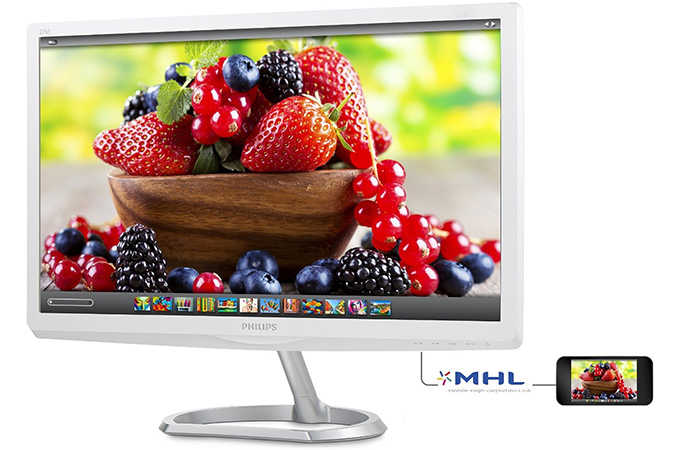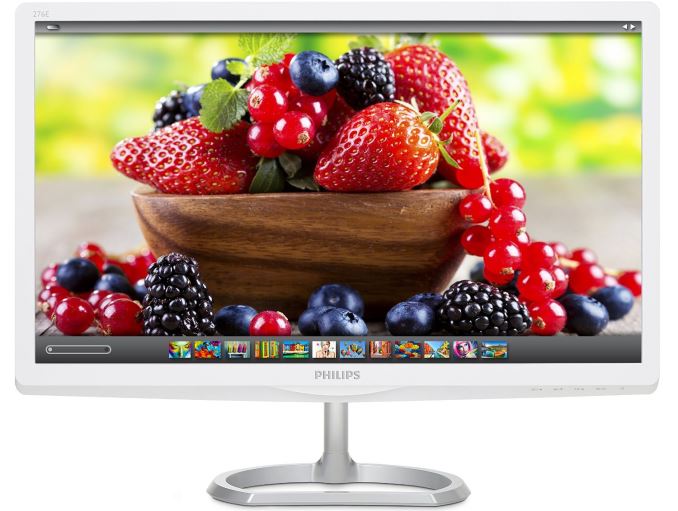Philips Begins Shipments of LCD Monitors with Quantum Dot Technology
by Anton Shilov on March 18, 2016 5:00 PM EST
TPV Technology, the company that produces monitors under Philips brand, has started to sell displays with QD Vision’s Color IQ quantum dot technology. What makes this notable is that QD Vision's technology is one such method being developed to significantly and inexpensively increase color gamut that displays can produce. The new 27” monitor can cover 99% of Adobe RGB color space, and is launcing at just $299.
The quality of LCD monitors as well as their ability to accurately display colors depends on multiple factors, including the quality of their panels as well as backlighting. While there are panels which can cover very wide color gamuts, since typical LED backlights usually do not produce whites with a broad underlying color spectrum, color accuracy of actual mainstream monitors gets limited. Several companies, including 3M and QD Vision, propose to apply special quantum dot filters on the backlights to make them as “white” (and therefore as broad) as possible.
QD Vision’s Color IQ quantum dot technology is based on cadmium selenide semiconductor nanocrystals, which can very precisely control spectral output of LED backlighting, essentially allowing light to be shifted to other wavelengths in a controlled manner. The quantum dots can be made to emit at any wavelength beyond the source wavelength with very high efficiency and narrow spectral distribution, which helps to make backlighting cleaner and thus enhance color gamut of displays. Applying quantum dot filters in any form is a relatively cost efficient task because it is basically a process step in assembly of an LCD module. However, those filters have to survive temperatures produced by LEDs, which is why they are not applied everywhere.
The Philips 276E6ADSS monitor is based on a 27" IPS-ADS panel with 1920×1080 resolution, 178°/178° horizontal/vertical viewing angles, 1000:1 contrast ratio (20M:1 dynamic contrast ratio), 300 cd/m2 brightness, 5 ms gray-to-gray response time and 60 Hz refresh rate. The display features a D-Sub, a DVI and an HDMI with MHL connectors along with audio in and out. Thanks to quantum dot film on the backlight of the monitor, the 276E can cover 99% of Adobe RGB color space, whereas typically inexpensive displays only show around 70% of the Adobe spectrum. The new Philips 276E monitor is made of plastic and uses a rather calm white/silver color scheme.
| Specifications of Philips Quantum Dot Display | |||
| Philips 276E6ADSS | |||
| Panel | 27" IPS-ADS | ||
| Resolution | 1920 x 1080 | ||
| Refresh Rate | 60 Hz | ||
| Response Time | 5 ms gray to gray | ||
| Brightness | 300 cd/m² | ||
| Contrast | 1000:1 | ||
| Viewing Angles | 178°/178° horizontal/vertical | ||
| Color Saturation | 99% Adobe RGB | ||
While the Philips 276E display is a product with a rather unique combination of low price and wide color gamut, for TPV Technology it is also a test vehicle for quantum dot technology from QD Vision. Since this is the first ever display with QD Vision’s Color IQ tech, some of its early samples had teething problems. The review unit received by AnandTech did not support constraining to the sRGB color gamut. As soon as we mentioned this fact to the manufacturer we were told that later versions should have a proper sRGB operating mode.
The new monitor is already available at Amazon, B&H and some other retailers for $299.

















40 Comments
View All Comments
Valantar - Sunday, March 20, 2016 - link
The review was at Tom's Hardware: http://www.tomshardware.com/reviews/philips-276e6-...I'm skeptical of the low pixel density, but I see how some might not care. Having to choose between brightness controls and a clearly visible green tint (before calibration), though, that's a deal breaker for me.
Samus - Saturday, March 19, 2016 - link
1080p on a 27" screen comes out to 82ppi. That's a pretty bad pitch. At 1440p it's 110ppi. 30% denser. That's highly noticeable unless you are 6' away, and let's face it this is a computer monitor nobody is sitting 6 feet back.scholarly_salamander - Friday, March 18, 2016 - link
I thought quantum dot displays were supposed to give us near-OLED levels of contrast. I guess I must have misunderstood, because 1000:1 is fairly pedestrian. The extended colour gamut doesn't excite me too much.mkozakewich - Saturday, March 19, 2016 - link
They should be brighter, because less light is filtered away, but I suppose contrast wouldn't change much. Either that, or they're using cheaper LEDs because of the benefits of the quantum-dot panel.zodiacfml - Saturday, March 19, 2016 - link
It is probably near OLED levels of color saturation.It is brighter and at the same time, no. It is not bright because the technology is a filter itself. It is bright because the lost light in the "blue" frequencies has been converted to Red and Green.
saratoga4 - Saturday, March 19, 2016 - link
>I thought quantum dot displays were supposed to give us near-OLED levels of contrast.They don't change the contrast, they change the color gamut of the backlight. Ideally for wide color gamut and good saturation you'd want separate R, G, and B LEDs, but thats more costly and somewhat power inefficient. With QDs you can take a normal blue LED and then precisely shift some of its emission into the green or red as if you had separate colored diodes but without the cost.
Yuriman - Friday, March 18, 2016 - link
I think the aesthetics are hideous, but if I were in the market for a monitor right now, I'd probably buy it anyway.jabber - Friday, March 18, 2016 - link
Switch it into Adobe mode and the world looks like its on LSD. I'll stick with sRGB.mkozakewich - Saturday, March 19, 2016 - link
This is a desktop peripheral. It'll look great with programs and content that support (and need) AdobeRGB.jabber - Saturday, March 19, 2016 - link
All three of them.